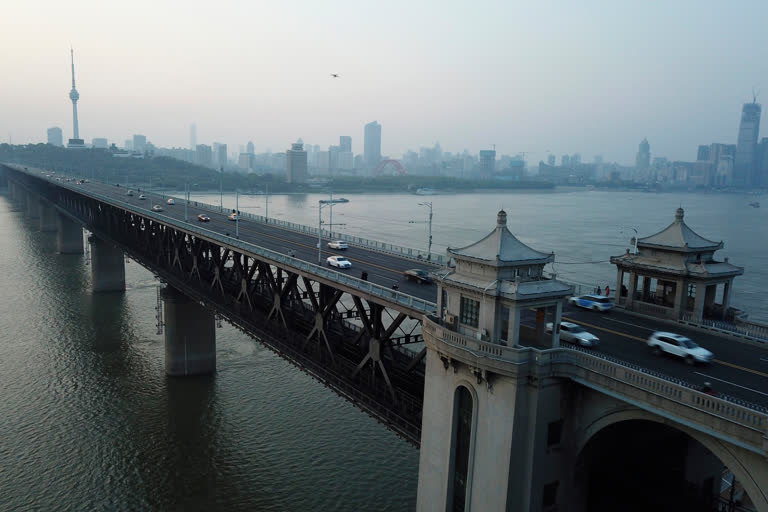Wuhan: Massive freight carriers are back on the Yangze, and so too are the ferries which take people across the five hundred metres which separate parts of the city.
The reopening of ferry services on the Yangtze, the heart of life in Wuhan for two millennia, was an important symbolic step to get business and daily life in this city of 11 million people back to normal.
Wuhan was one of China’s most important centers under inward-looking dynasties that had little interest in foreign trade and carried out commerce and politics over the country’s vast river networks.
The city was eclipsed by the explosive rise of Shanghai, Hong Kong and other coastal cities after the ruling Communist Party set off a trade boom by launching market-style economic reforms in 1979.
Read Also: Egypt washes down Giza Zoo with disinfectant
Today, Wuhan is regaining its status as an economic dynamo as Chinese leaders shift emphasis from exports to developing more sustainable growth based on domestic consumer spending.
The city government says more than 300 of the world’s 500 biggest companies, including Microsoft Corp. and Honda Motor Co., have operations in Wuhan to get access to central China’s populous market.
The metropolis was formed from three ancient cities — Wuchang, Hankou and Hanyang — at the meeting of the Yangtze and Han rivers that grew together.
The emperor Kublai Khan visited in the 13th century when China was part of his Mongol empire and Shanghai was a fishing village of a few thousand people.
In the mid-19th century, Wuhan became, along with Shanghai, Tianjin and Qingdao, one of a series of “treaty ports” where China’s Manchu rulers were forced to give Western powers trading privileges and exempt their people from local laws.
A rebellion began on Oct. 11, 1911, in Wuhan that spread across the country and led to the breakup of the Manchu empire and the founding of President Sun Yat-sen’s Republic of China.
Read Also: Look, how wildlife ventures into new places
The Yangtze’s water is very sweet, communist leader Mao Zedong said after he swallowed a mouthful while swimming in the 1950s, according to a report from the time.
Meandering 6,300 kilometers from Tibet’s Tanggula Mountains to the East China Sea, the Yangtze is the longest river in Asia and the world’s third-longest.
It and the Yellow River in the north are the mother rivers of the nation, much like America’s Missouri and Mississippi or Eastern Europe’s Danube. It is also the site of the Three Gorges Dam, the world’s biggest hydroelectric project.
The Yangtze stars in countless poems, songs and history-making events including the third century “Battle of Red Cliffs,” which was fought by one of China’s wiliest strategists, Zhuge Liang. The story, involving armored battleships, has been turned into a traditional opera and a 2008 blockbuster movie directed by John Woo.
Today, Wuhan produces agricultural chemicals, 6% of China’s cars and components for smartphones, industrial machinery and optical devices for markets in Europe and North America. Skyscrapers loom above parks and ancient temples.
Ships carry goods 700 kilometers downriver to Shanghai by way of Nanjing, another ancient inland city.
Shipping, however, plunged after the coronavirus outbreak started in Wuhan late last year and led to a strict lockdown of the city. Traffic near Wuhan fell by as much as 70%, according to HawkEye 360, a company in Virginia that follows radio communications and ships’ satellite-linked tracking beacons.
Traffic is back to less than half its pre-outbreak level, the company says.
Mao’s face, etched in a giant gold coin, perches atop a stone obelisk in the Bund, the riverfront former center of Western business activity and now a tourist spot. On it is etched a poem by Mao calling for a bridge to be built across the river.
That bridge was finished in 1957, cementing Wuhan’s renaissance as a transportation hub by connecting rail networks in northern and southern China.
That connection is one reason the coronavirus spread so fast.
Wuhan's Huanan Seafood Market where scientists suspect the virus might have jumped from a bat to humans is next door to the Hankou Train Station.
Authorities have since decontaminated the station and on April 11, high-speed trains began leaving Wuhan for Beijing again. The ferry system had opened a few days before.
Most of Wuhan is thinking the same way and tightening its belt after factories, restaurants, shopping malls, cinemas and almost every other business except supermarkets were shut for 2 1/2 months. Jittery consumers aren’t spending much. Manufacturing has yet to get back to normal levels.
But the public has returned to the banks of the Yangtze, known in Mandarin as Chang Jiang or Great River.
Couples wearing masks walk hand-in-hand. Fishermen flick long rods out across the babbling waters. Joggers run past picnickers. People fly kites shaped like butterflies, birds, lanterns and fighter jets. A ship's horn blares.
(AP)



